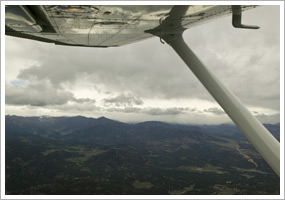| The following stories from the May 27, 2011, edition of AOPA ePilot were provided to AOPA members who expressed an interest in the particular subject areas. Any AOPA member can receive information tailored to their areas of interest by updating their preferences online. |
training tipsWeather-wary, and wise As summer 2011 approaches after a long, snowy winter, followed by a tornado- and flood-filled spring, pilots have been given more than enough reminders of the importance of weather awareness. Fine-tune your prep by paying special attention to clues that rapid change may be afoot during your expected time aloft. A high dew point that appears in your departure airport’s or destination’s surface aviation weather observation METAR tells you that the atmosphere could become very active. “High dew points correlate well with the probability and severity of thunderstorms,” Thomas A. Horne explained in the March 2003 AOPA Pilot Wx Watch column. “Once thermals, fronts, and other lifting forces go to work on air masses with high dew points, towering cumulus or cumulonimbus clouds can soon follow.” He added this important caution: “Most severe thunderstorms (those with 50-plus-knot surface winds, three-quarter-inch hail, or tornadoes) happen in air masses with dew points above 70 degrees F (21 degrees C).” Even if your last weather briefing still seems fresh, update it just before departure and check the latest radar imagery for any signs of new activity. Good to go? Have your list of frequencies for your personal early warning network handy. It should include Flight Watch and navaids that broadcast hazardous inflight weather advisories (HIWAS). The broadcast of a convective sigmet may be your first alert to weather developments. “When first issued, ATC will broadcast convective sigmets over frequencies used in instrument flight rules operations. VORs with HIWAS capability will broadcast convective sigmets. And, of course, flight service will tell you of any convective sigmets via flight watch (122.0 MHz) or one of its designated flight service frequencies,” Horne wrote in the June 2001 Wx Watch. Under favorable conditions, no adverse weather comes to life more spontaneously, and can develop more quickly, than a thunderstorm or an area of thunderstorms. Just as you scan your instruments for proper heading, altitude, and airspeed, keep checking your early-warning system on weather conditions ahead, and be ready with alternate plans of action for every point along your route. The Air Safety Institute’s WeatherWise: Thunderstorms & ATC online course can give you additional insights about safe approaches to convective activity. training productsUniversal GPS receiver from Sporty’sYou can turn your smartphone or iPad into a GPS with the right application and a universal GPS receiver. This unit, sold by Sporty’s, communicates via Bluetooth with iPad, iPhone, iPod Touch, and many Android, Windows, and Blackberry smartphones and tablets. Use the receiver with ForeFlight, WingX, or other programs. Its rechargeable battery lasts 8.5 hours, and it comes with both a USB cable for charging and a 12-volt car charger. The receiver sells for $99.
Note: Products listed have not been evaluated by ePilot editors unless otherwise noted. AOPA assumes no responsibility for products or services listed or for claims or actions by manufacturers or vendors. final exam
Question: What is the difference between best rate-of-climb speed and best angle-of-climb speed?
Answer: Normally after takeoff a pilot is interested in reaching cruise altitude in the shortest possible time. Only one speed will do that: best rate-of-climb speed, or V Y. This airspeed provides the greatest gain in altitude in the least amount of time. There are other instances, such as obstacles, when a pilot wishes to gain as much altitude as possible in the shortest distance. In this case, a pilot would choose the best angle-of-climb speed, or V X, which provides the greatest gain in altitude in a given distance. The different airspeeds that either limit or result in specific aircraft performance are known as "V" speeds—V for velocity. The different V-speed abbreviations are listed in 14 CFR 1.2. For more information on all the V-speeds and their effect on aircraft safety and performance, read about airspeed on AOPA Online.
Got a question for our technical services staff? E-mail [email protected] or call the Pilot Information Center, 800/872-2672. Don’t forget the online archive of “Final Exam” questions and answers, searchable by keyword or topic. |
 Every experienced pilot can tell a story about encountering surprising weather. But the story is only something to learn from if that pilot did a good job studying the weather before and during the flight.
Every experienced pilot can tell a story about encountering surprising weather. But the story is only something to learn from if that pilot did a good job studying the weather before and during the flight.
